 Contact us
Contact usIntent
Community
Studio Organo Concepts
About Us
Subsidaries
Studio Organo
TS RERA No.P02400003403.
TS RERA No.P02400003403.
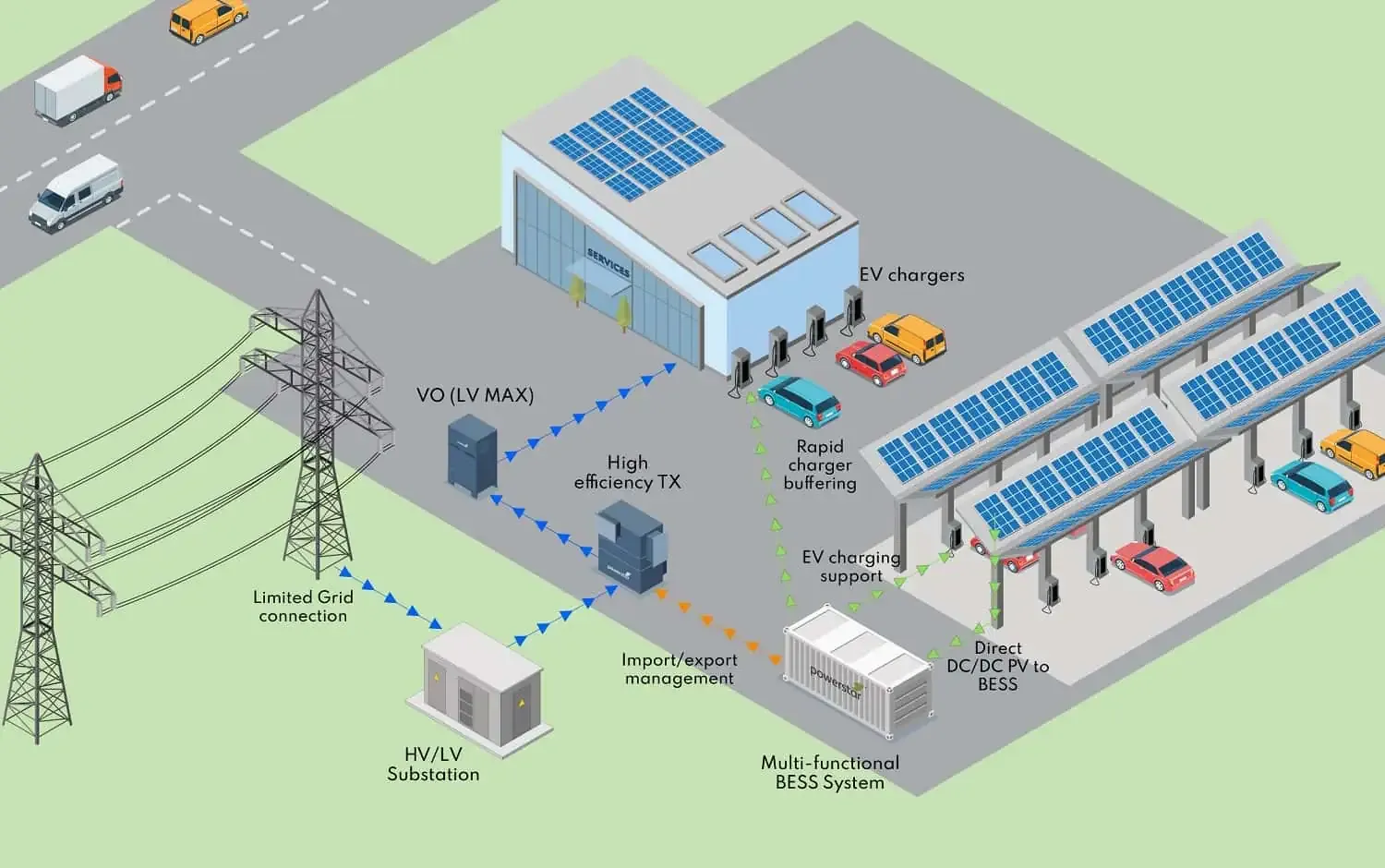
Key Insights into Battery Energy Storage Systems (BESS):
Capturing Surplus Energy: BESS possesses the extraordinary ability to store surplus electricity generated during periods of abundance, such as when renewable sources like solar and wind produce more power than the immediate demand requires. This not only reduces wastage but also serves as a strategic reserve to tap into during peak consumption periods.
Grid Stabilization: BESS plays a critical role in stabilizing electrical grids. Its agile capacity to absorb or inject power enables it to respond swiftly to fluctuations in supply and demand, ensuring steady voltage and frequency within the grid, thereby acting as a safety net against erratic grid behaviour.
Peak Shaving: Peak energy consumption can strain conventional power plants both environmentally and economically. BESS intervenes by supplying stored energy during high-demand moments, effectively reducing both costs and the ecological footprint associated with peak load power generation.
Empowering Microgrids and Remote Areas: In regions with limited grid connectivity, BESS is a saviour. By providing consistent power in microgrids and remote areas, it fosters energy security and resilience against grid outages.
Dependable Backup: A hallmark feature of BESS is its ability to act as a reliable backup during power outages, seamlessly taking over when the main power source fails to ensure an uninterrupted supply to critical systems.
In the following sections, we analyse three specific cases, using Organo Kandawada as our reference point. All calculations and scenarios presented here are tailored to meet Organo Kandawada's unique energy requirements and infrastructure.
Case 1:
Survive and Thrive: Conventional DG Setup's Power Outage Solution
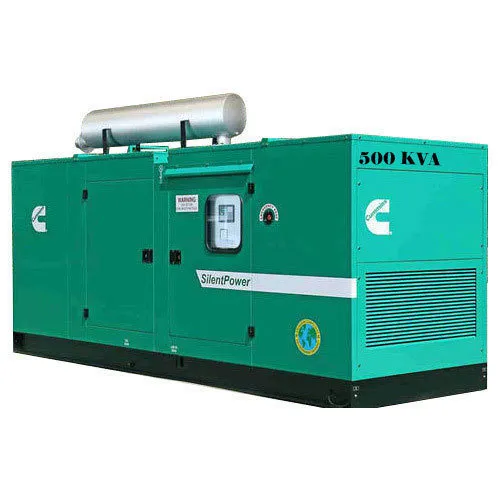


Case 2:
Organo Naandi's Power Duo: DG Setup and UPS for Uninterrupted Living
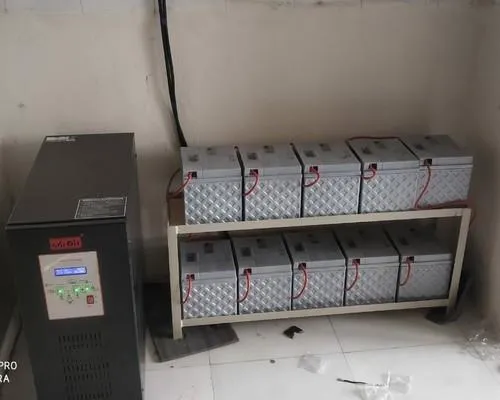
In the previous case mentioned above, there exists a deliberate time delay of 10-15 seconds before the DG system activates and delivers power. This practice is commonly adopted by Original Equipment Manufacturers (OEMs) to prevent frequent system activations.
At Organo Naandi, a 5 KVA UPS system serves as a 30-minute backup solution. The DG system is engaged only after this half-hour window. This strategic arrangement not only ensures backup power but also curtails the DG runtime, subsequently minimizing diesel consumption.
Nonetheless, certain drawbacks are associated with this setup:
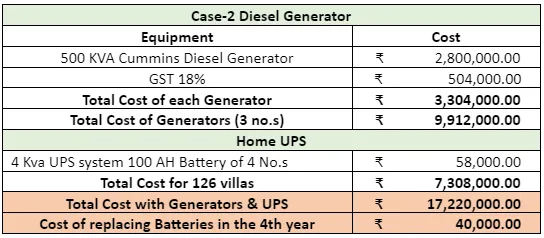
Case 3:
Organo Kandawada's Green Revolution: Shedding One DG, Embracing Centralized BESS

As a key component of our strategy, we are streamlining our power infrastructure by eliminating one of the three proposed DG sets. In its place, we are implementing a centralized battery system (BESS) with the capacity to provide a comprehensive 1-hour backup. In a complementary manner, the two remaining DG sets will seamlessly transition into the backup role once the battery bank's energy is depleted.
Within this integrated system that encompasses four power sources (Solar, Grid, DG, and Batteries), our advanced Battery Management System (BMS), which comes with the BESS takes centre stage. The BMS allows us to tailor our power priorities to meet specific needs. During the morning hours, the solar source takes precedence, harnessing the maximum available sunlight. As nighttime falls, the order of preference shifts to battery power, followed by the grid, and then the DG sets. These preferences can be easily customized to suit changing demands.
In the event of a grid failure, our on-grid solar system automatically deactivates. This situation is addressed through the Battery Energy Storage System (BESS) that takes over by providing the necessary reference voltage to enable the solar system to continue generating energy. This innovative approach ensures a continuous power supply, even when the grid is unavailable. When the solar system generates energy during such a scenario, the primary objective is to fulfil the immediate load demand. Simultaneously, any surplus energy is directed towards charging the batteries within the BESS. This dual-purpose utilization optimizes energy usage, contributing to both load requirements and battery storage replenishment. If surplus energy remains beyond the load demand and battery charging needs, the BMS takes proactive measures. It sends precise signals to the inverter, instructing it to curtail the solar system's power generation. This dynamic response ensures that energy generation aligns with immediate consumption and storage priorities.
As the BESS seamlessly integrated with the Main LT panel and DG panel. An important safety measure is enacted: when the battery charge drops to 20%, the DG set is automatically initiated. Ensuring that the DGs are maintained at over 30% of their rated capacity safeguards against the potential damage caused by reverse spinning, thus preserving the integrity of generator components.
Through this integrated and intelligent approach, we're not only guaranteeing a consistent power supply during grid failures but also optimizing energy usage by prioritizing load demand and battery charging. This strategy underscores our commitment to efficiency, adaptability, and sustainable energy management.
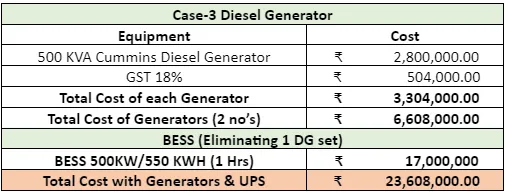
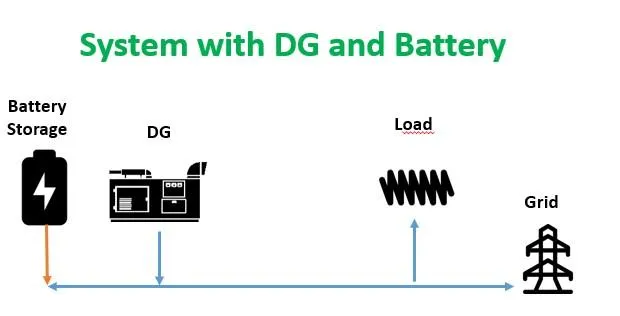
Graphical Representation with all the Three cases:

Home UPS vs. BESS: The Ultimate Showdown for Savings:
Presently, the typical lifespan of Li-Ion batteries is approximately 6000 charging cycles, equating to a remarkable 16years of operational longevity. However, within our prudent evaluation, we are contemplating a span of 12 years. During this 12-year timeframe, we anticipate regular Home UPS to undergo three routine replacements of the batteries.
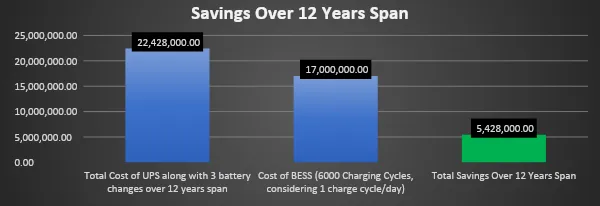
Crunching the Numbers: What Does It Really Cost to Generate 1 Unit of Power:
As per the below chart it can be clearly interpreted that BESS charges less amount when compared to a regular DG set.

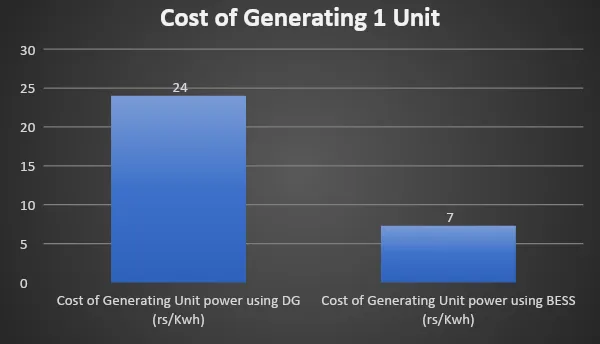
5-Year Showdown: DG vs. BESS - Who Wins the Cost Savings Battle:
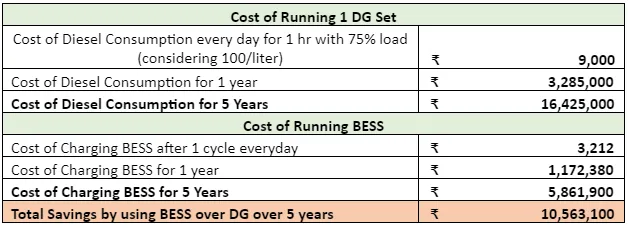

Summary:
The data presented in the graph clearly illustrates that the investment in a 500KVA BESS can be recovered within a period of 6 years when compared to the expenses associated with operating a 500 KVA DG set over the same 6-year timeframe. This compelling cost analysis underscores the financial advantages of adopting BESS as an energy solution.
Reference Links:
We are a cross-functional and research-focused team of architects, engineers, and technical experts, who ideate, refine and detail eco habitat products, components, and solutions. Our core intent is to co-create and manifest apt rurban lifestyles across all eco-habitat components to celebrate the living for respective user groups. From earth-friendly neighborhoods to home interiors, we’ve got it all covered.
Instagram: https://www.instagram.com/studioorgano/
Website: https://www.organo.co.in/studio-organo
If you’d like to know about our design explorations or if you would like to be part of our user research as we refine the design, please email us at studio@organo.co.in